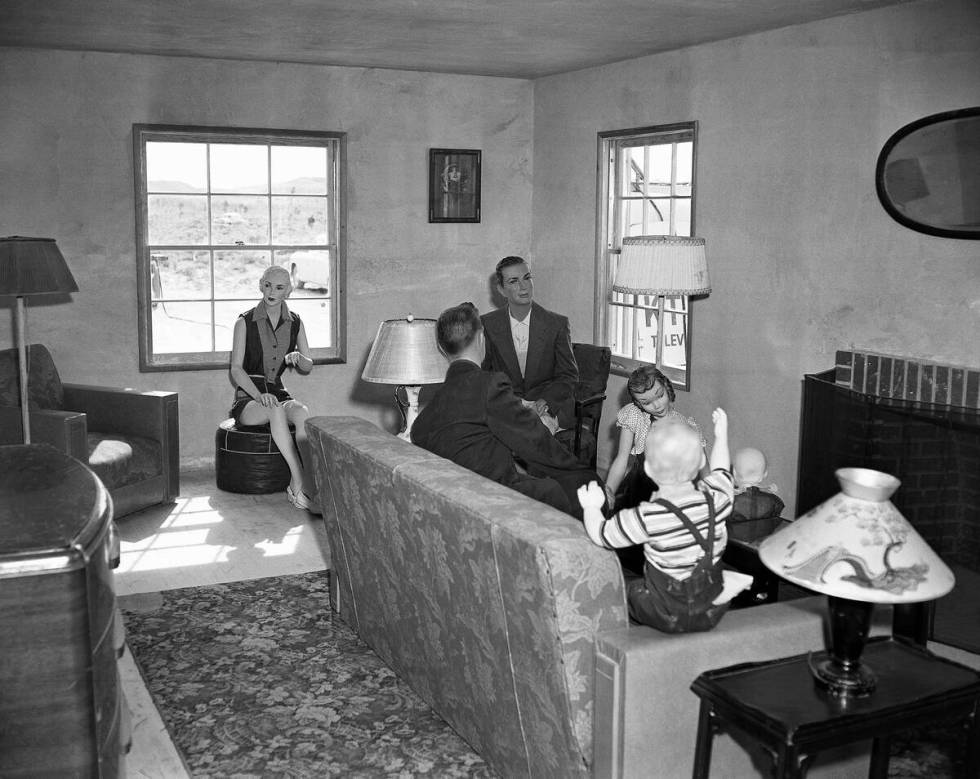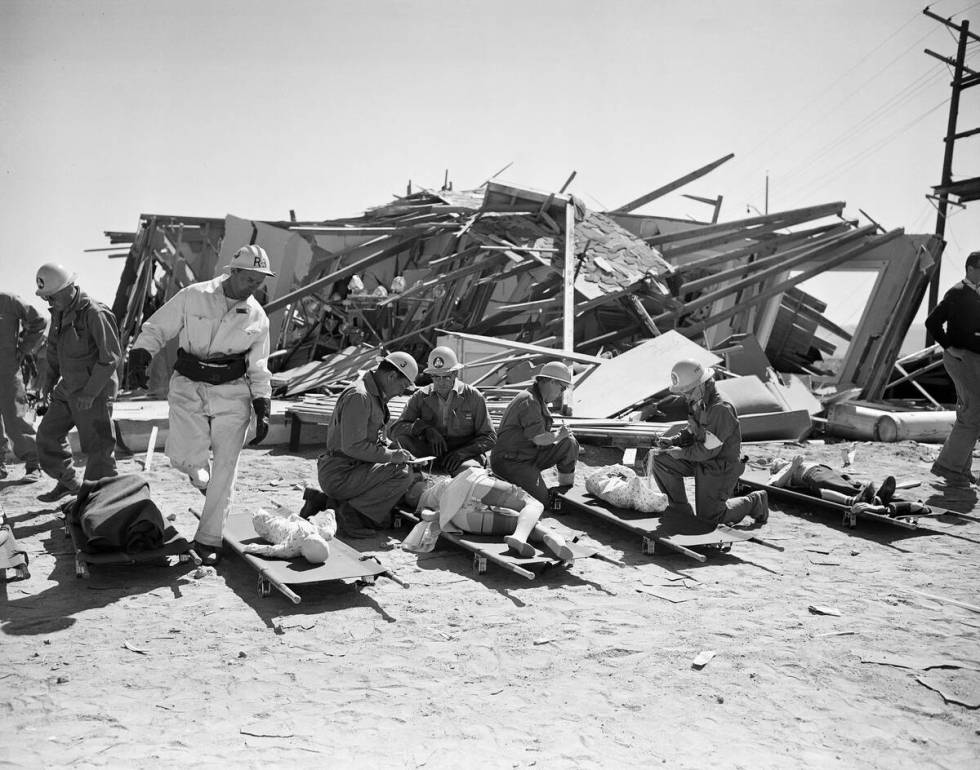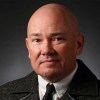The Nevada Test Site didn’t waste any time.
President Harry Truman established the site, a 680-square-mile section of the Nellis Air Force Gunnery and Bombing Range, on Dec. 18, 1950.
Less than six weeks later, a 1-kiloton device, equivalent to 1,000 tons of TNT, was dropped from an Air Force B-50 bomber.
It was the first of 928 nuclear tests, 100 of them above ground, at what was originally known as the Nevada Proving Grounds and is now referred to as the Nevada National Security Site.
We asked the Atomic Museum’s Joe Kent, deputy director and curator, and Matt Malinowski, director of education, about the most significant blasts at the test site.
Here are five of their picks, with the series name followed by the test name, along with how the Review-Journal covered them.
Ranger/Able
Date: Jan. 27, 1951

What it was: This was the first atomic test in the continental U.S. since the Manhattan Project’s Trinity test on July 16, 1945.
“It was very much, ‘OK, let’s get started. Let’s see how it goes,’ ” Kent said.
How we covered it: “Roulette wheels and dice tables, which operate 24 hours a day here, were still doing a brisk business when the blast went off around 5 a.m.,” we wrote.
“In the Golden Nugget, a man standing at one of the craps tables felt the shock. He paused and looked around.
“‘Must be an A-bomb,’ he said. He turned back to the table and went on with the game.”
Local insurance agent O.A. Kimball said one of his clients called before dawn to tell him the plaster on her walls and ceiling were cracked by the explosion.
“‘The doors really played a tune when the thing went off,’ Kimball reported her as saying, ‘and I was afraid for a few minutes the house would fall down.’”
Upshot-Knothole/Harry
Date: May 19, 1953

What it was: This 32-kiloton test became known as “Dirty Harry” when the fallout, which was intended to land between Alamo and Glendale, was blown downwind into St. George, Utah.
“That’s probably the quintessential test that is tied to the downwinder movement,” Kent said of the presumed victims of the blast who were exposed to radiation.
How we covered it: “The cloud, which was barely visible in Las Vegas because of the overcast, gray dawn, traveled in an east-southeast direction and the atomic energy commission (sic) established highway checkpoints on Highways 91 and 93 to warn motorists of the possibility of radioactive fallout.
“The checkpoints were established at St. George, Alamo, Glendale and Nellis air force base (sic) and were a precautionary measure. No hazardous levels of radioactivity were reported.”
The next day, we checked in on St. George.
“Having an atomic cloud hover over their town caused little concern to the men, women and children who live in St. George, Utah, who kept indoors several hours yesterday after atomic energy commission officials reported that there would be some fallout there after yesterday morning’s shot.”
St. George resident Dick Hammer estimated between 30 and 40 people, most of them tourists, were in his Dick’s Cafe when the word that people should remain indoors came over the radio. One woman, he said, wondered what would happen to them.
“ ‘Hell, lady, I don’t know,’ Hammer replied, ‘but I don’t think you have much to worry about.’ ”

Teapot/Apple 2
Date: May 5, 1955
What it was: This was the second of “two highly publicized civil effects tests just to see what would happen to a small town,” Kent said. “What would be the concerns if the town was hit with one of these bombs.”

It’s also the test that inspired the scene in “Indiana Jones and the Kingdom of the Crystal Skull” in which Indy rides out a nuclear blast in a refrigerator.
A 29-kiloton device was dropped from a 500-foot tower near Doom Town, the symbolic burgh made up of fully furnished homes, a radio station, a gas station and other signs of civilization, with mannequins representing the residents.
How we covered it: “A fearsome nuclear weapon bludgeoned this guinea-pig city today while the civil defense teams staged a dress rehearsal of their possible roles in the atomic age.
“Dummies dressed as men, women and children were grouped under the atom’s devastating might in an experiment to determine how families in an American target city might survive the fury of nuclear warfare.”
The blast was described as “a spectacular orange, blue and purple fireball.”
The next day, officials got a full look at the damage.
“Death and serious injury struck the dummy men, women and children of Doomsday Drive, the little dirt road lying only 4,700 feet from ground zero,” we wrote.
“A mannequin mother died horribly in her one-story home of pre-cast concrete slabs. Portions of her plaster-and-paint body were found in three different areas. A mannequin tot, perhaps the size of your 3-year-old, was blown out of bed and showered with needle-sharp glass fragments. This house withstood the blast, but its occupants may not have.”

Plumbbob/Hood
Date: July 5, 1957

What it was: A 74-kiloton thermonuclear device was dropped from a balloon, sending an atomic cloud 49,000 feet into the air, as part of the largest above-ground test at the site. The test is featured in the Atomic Museum’s Ground Zero Theater.
It also was part of the Desert Rock exercises, essentially war games designed to test how members of the military would perform during an atomic war.
“They would have these exercises along with the blasts,” Malinowski said. “So the troops would be put into foxholes or trenches, told to stay down low, not to look directly at the light while it was going off.”
How we covered it: “Nuclear scientists this morning fired the largest atomic blast ever to be detonated in the continental United States and the resulting explosion caused veteran observers 13 miles from ground zero to gasp with awe at its terrible immensity.
“The flash and fulminating fireball caused joshua (sic) trees and yucca plants near zero to burst into flames, making the desert floor resemble a flaming city.”
Elsewhere in that edition, it was reported that “a United Airlines pilot flying from Honolulu to Los Angeles radioed that he saw the light of the Nevada blast as his plane cruised 1,000 miles off the California coast.” A bright flash was reported in San Francisco, while residents in Hollywood, Anaheim and Newport Beach reported feeling “two jarring shocks” at 5:05 a.m., 25 minutes after the detonation.
Julin/Divider
Date: Sept. 23, 1992

What it was: This underground vertical shaft test of less than 20 kilotons proved to be the final full-scale test at the site. It wasn’t designed to be, but a nine-month testing moratorium went into effect on Oct. 1. The next year, it was extended indefinitely.
“They still do subcritical testing on the weapons stockpile out there,” Malinowski said. “So even though they’re not doing full-scale detonations, there are experiments they do to kind of verify that the stockpile is still well-maintained and active.”
How we covered it: “The United States conducted its sixth nuclear weapons test of the year Wednesday at the Nevada Test Site, five days after the last one, while four Belgian anti-nuclear activists hid within a mile or two of ground zero, U.S. authorities said.
“The four — three men and a woman — said they feared for their safety as Department of Energy scientists began counting down the last five minutes prior to the 8:04 a.m. detonation, prompting them to flee on bicycles to a safer location, some three miles from ground zero.”
They were arrested there about an hour later.
“I was kind of scared,” said Michiel De Grande, 25, outside the Foley Federal Building after he was ordered to appear the next day for a hearing on federal trespass charges. “The feeling inside was real strange, the feeling of the pain of the Earth. It shook for 10 seconds. Even before the bomb exploded you could feel the Earth crying.”
Contact Christopher Lawrence at clawrence@reviewjournal.com or 702-380-4567. Follow @life_onthecouch on X.













